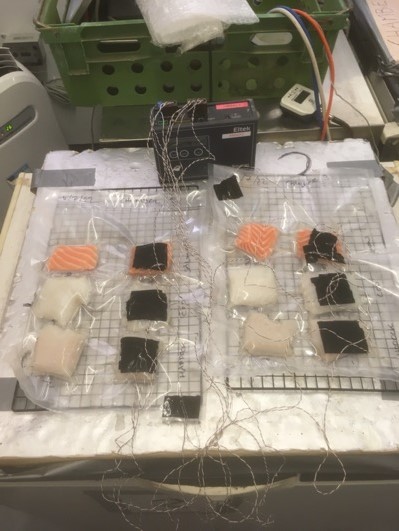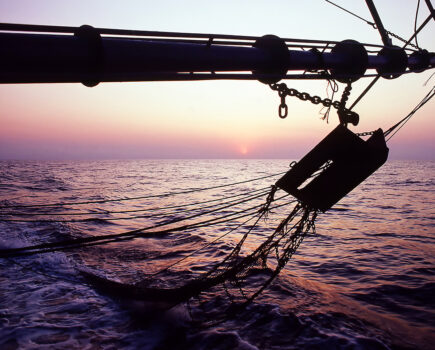With the UK Seafood Innovation Fund’s latest research and development projects underway, Fishing News is delving into some of the innovations that the fund has supported. This week: how two different supply chain innovations could help feed the UK’s appetite for seafood and benefit UK fishermen
Each year, an estimated 35% of seafood harvested worldwide is wasted. Spoilage is one of the key reasons why some seafood never reaches people’s plates, and in the UK, the supply chain is keen to tackle this.
While spoilage may not directly impact fishermen, measures to reduce it can often affect the quality of seafood. This means that finding ways to prevent spoilage, while preserving flavour, could be a huge positive for the demand for UK-caught seafood.
In May this year, the UK Seafood Innovation Fund (SIF) awarded £293,731 in funding to the University of Stirling for the research and development phase of its project to develop a ‘cocktail’ of bacteria-eating viruses (bacteriophages), to combat the bacteria that cause unpleasant smells in langoustines and put people off eating them. As they are harmless to humans, they are safe for treating seafood.
The feasibility stage of the project, funded by SIF in early 2022 to the tune of £47,272, saw the successful identification of several adverse species of bacteria, and phages able to slow their growth. Now, the team at Stirling – along with partners the Centre for Phage Research at the University of Leicester and the Center for Evolutionary Hologenomics at the University of Copenhagen – is homing in on which bacteria should be the priority to target, and which phages will work best against them.
The aim is to extend the shelf-life of langoustines as much as possible; according to processors, even just being able to gain an extra day before spoilage would be of huge benefit.
With the langoustine fishery being the UK’s second most valuable, yielding £112m in exports in 2021, members of the industry have already shown keen interest in the project – as have fishermen, who don’t want to see good shellfish go to waste. “They care about the product that they’re catching,” said Ben Clokie, research fellow in the Institute of Aquaculture at the University of Stirling.
While the University of Stirling is on the hunt for bacteria-munching phages, the Grimsby Institute of Further and Higher Education – part of the TEC Partnership – and the National Centre for Food Manufacturing at the University of Lincoln are investigating something altogether different: how to take the temperature of seafood down to below its freezing point without actually freezing it (that is, bypassing the formation of ice crystals).
This phenomenon is known in nature as a ‘super-cooled’ state. Achieving the same in seafood would enable the supply chain to avoid the loss of taste and texture that ice crystals can lead to in food that has been frozen.

Trials of ‘super-cooling’ – where a substance’s temperature is taken down to below its freezing point without the formation of ice crystals – on samples of a range of different fish species. Perfecting this method for use in commercial settings would allow the preservation of seafood without the loss of quality and taste that results from freezing.
In the feasibility stage of the project – which received £38,620 in funding from SIF – the Grimsby Institute was able to demonstrate that vacuum-packed cod, haddock, salmon and mackerel could all be stably super-cooled for at least 20 days.
Graham Purnell, senior lecturer/consultant in food cool chain and process automation at the University of Lincoln, can confirm first-hand that super-cooling preserves taste; while the project involves plenty of cutting-edge science and technology, ultimately, the only way to know how consumers might experience super-cooled seafood was for the researchers to eat it themselves.
A further focus of the current research and development project is to explore how the super-cooling method can be applied commercially – a topic that the researchers have been exploring with the members of the industry. Graham Purnell said that while the adoption of super-cooling would require changes to some factory floor processes and practices, it would be unlikely to involve major investment, and could improve flexibility in the supply chain overall. There may even be scope for the larger of the UK’s fishing vessels to super-cool their catch, where processing is carried out onboard before returning to port.
One key barrier that both the super-cooling and bacteriophage projects anticipate is legislation. Their techniques are so novel that they currently occupy a grey area. Do bacteriophages applied to langoustines count as an additive, or as a disinfectant? How do you define seafood that isn’t chilled, and isn’t frozen? However, the project teams are optimistic that this can be surmounted.
For both projects, SIF funding has been essential for getting the innovations underway. “I think it would probably have been impossible to get the funding otherwise,” Ben Clokie commented, while Graham Purnell added: “The SIF funding has helped us to create a non-competitive space where businesses are willing to collaborate and let us expand the scope to multiple fish supply chains.”
Ultimately, everyone with a stake in seafood will gain from ideas like these. As Amaya Albalat, senior lecturer at the University of Stirling and lead for the SIF bacteriophage project, said: “Developing the right technologies to extend seafood shelf-life allows all involved in the supply chain, including consumers, to minimise losses and waste.”
The UK Seafood Innovation Fund (SIF) is part of the UK government’s £100m UK Seafood Fund. Through multiple calls since 2019, SIF has awarded a combined total of £17m to 116 feasibility or research and development projects across fisheries, aquaculture, processing and the supply chain. Its aim is to boost the resilience and sustainability of the UK seafood sector by supporting a diverse range of innovative and scalable ideas.
SIF is administered by the Centre for Environment, Fisheries and Aquaculture Science (Cefas) on behalf of the Department for Environment, Food and Rural Affairs (Defra).
For more information, click here.

This story was taken from the latest issue of Fishing News. For more up-to-date and in-depth reports on the UK and Irish commercial fishing sector, subscribe to Fishing News here or buy the latest single issue for just £3.30 here.
Sign up to Fishing News’ FREE e-newsletter here.








